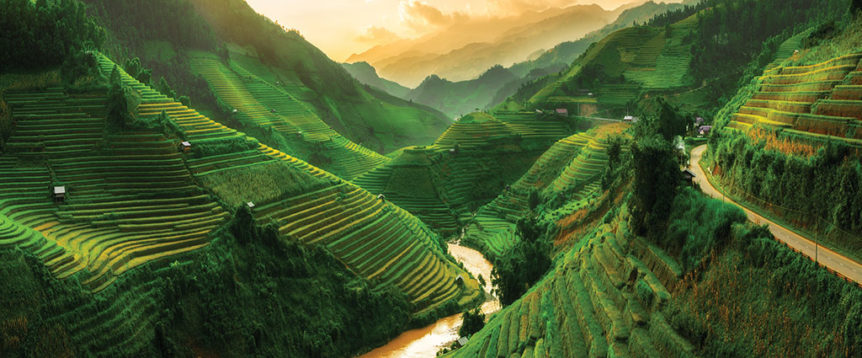The coast of Vietnam snakes in an “S” shape from Hanoi in the north to Ho Chi Minh City (Saigon) in the south, by the South China Sea. Bordering China, Laos and Cambodia, Vietnam draws its culinary influences from countries around the globe, among them neighboring China and Thailand, as well as France, whose era of colonization spanned parts of the 19th and 20th centuries.
Bright, light, fresh flavors characterize the cuisine, which often features a base of rice or noodles topped with seafood, meat, fresh herbs and fish sauce. According to Andrea Nguyen, author of Vietnamese Food Any Day (Ten Speed, 2019) and several other award-winning cookbooks, Vietnamese food is different from other cuisines because it is layered with sweetness, saltiness, spicy heat and cooling fresh herbs—a “fusion of cultures” resulting from a long history of interactions with other nations. Nguyen notes that in some parts of the country, Roman coins have been found (one theory is that Vietnamese fish sauce originated with the Roman fish sauce known as garum), and there has been influence from the Japanese, who occupied the country after the French, and from the American presence during the Vietnam War.
“People think that making Vietnamese food, if it’s not familiar to them, is going to be really difficult,” Nguyen says. “But all that they really need to start off with is fish sauce and rice.” One of the best features of Vietnamese food is that it is customizable to an eater’s personal tastes; what you put into your roll, soup or sandwich can vary based on your preference of meat, vegetables and garnishes. There are three “gateway foods,” as Nguyen calls them, for newbies to easily make and try: rice-paper rolls, pho (pronounced fuh) and banh mi sandwiches.
Rice-paper rolls are made with a thin rice-paper wrapper and can be filled with rice noodles; slices of pork, shrimp or tofu; and herbs and served with a peanut dipping sauce. Pho is a rice-noodle soup, made with a rich broth, plus a selection of meats, and topped with fresh herbs, jalapenos and lime juice. A banh mi sandwich is made using a French bread–style roll with distinctively Vietnamese fillings, including grilled pork, pickled daikon radish and shredded carrot, plus fresh cilantro and jalapeno slices.
In her latest book, Nguyen breaks down Vietnamese cooking so that it’s easily understood. She starts with a detailed guide of essential, readily available ingredients. “I want Vietnamese cooking to be a weekday thing, not a weekend project,” Nguyen says. “I want you to know you can do it any day, and all of the ingredients, like lettuce, cucumber, herbs, flour, sugar and butter, are available in a typical American pantry or supermarket.” Her hope is that some Vietnamese favorites will become part of every home cook’s regular meal roster.












